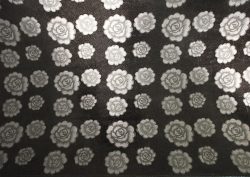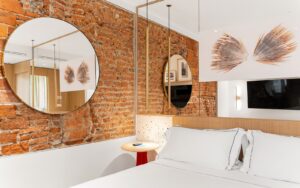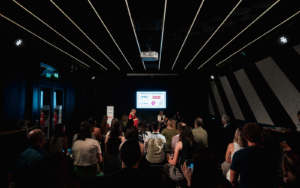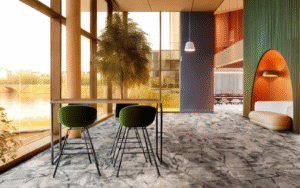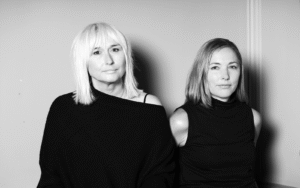At the Surface Design Show 2025, Hotel Designs Editor Sophie Harper welcomed interior design and architecture greats onto the main stage to discuss the future of surfaces within hospitality spaces. Meghan Taylor writes…

Before a pen and notepad wielding audience — poised for notetaking — a distinguished panel of industry experts gathered to discuss the future of surface design in hospitality. Moderated by Hotel Designs’ own Sophie Harper, the conversation featured insights from Christos Passas, Director at Zaha Hadid Architects, John Paul Pederson, Creative Director at Wimberley Interiors, Ramona Bittere, Founder and Creative Director at Moncé Designs, and Tina Norden, Partner and Principal at Conran and Partners.
Together, they discussed the future of surface design in hospitality with a focus on up and coming materials, sustainable materials (and what that means in design), and how this leads to the curation of the intended design, and guest experience, within a hotel setting.
Longevity
Kicking off the talk, Sophie asked the panellists their thoughts on sustainable materials and how surfaces contribute to eco-friendly designs.
Tina Norden set the tone with a thought-provoking response: “For Conran and Partners, a sustainable material is a material that has a lifespan, and that can actually stay in a place for a long period of time. I think anything that you specify, if it only lasts for a year or two, it’s not very sustainable.”
“When you think about hospitality design, typically, it’s a five-year or maybe a seven-year cycle for refurbishment. Does it need to be that way? Or can we actually specify so that materials can be there for a much longer period of time.”
Continuing, Tina admitted that it is often budget limitations which prevent designers using the better quality materials that would stand the test of time. Though she added that choosing the cheaper option is a kind of ‘false economy’. In the long run, spending that bit more at the off will reduce waste and refurbishment frequency, and therefore costs.

Image credit: Surface Design Show
Reusability
The panellists agreed with this approach, with Christos commenting that “hospitality projects are much more than the surface materials. There is attention to be given to the structure and the materials used in the structure, whether it’s concrete, steel, or wood. There’s a lot of interesting products in the ceramics and the wood industry these days.”
“But I absolutely agree that longevity is the way to go, and also recyclability,” Christos noted, “so dismantling and being able to reuse is something we try to follow more and more.”
Turning to the recyclability of materials, Ramona commented that, to her, that was the beauty of a project, ‘that we can reuse an existing surface and actually expand the lifespan of it’.
“Sometimes it comes with its challenges as well,” she added, “but we often have the conversation at the start and say that as material ages it gains character and it brings something to the project.”

Image credit: Surface Design Show
Locality
Additionally, the panel brought up that advancements in technology, such as 3D printing and material recycling innovations, must also be recognised as key factors in sustainable material development too.
John Paul then introduced the idea of using local surface materials as a sustainable design method. “We have an ethos in the studio that focusses on an honesty with materials; focussing on the location of the project and celebrating this by using a material made from a local technique or supplier. It’s not necessarily a recycled material, but it’s something of that region, which brings the design story back to that local culture.”
“Do you always start by looking at the local landscape and using locally-sourced materials, when possible?” Sophie asked the panel.
To which, ‘definitely’ was the resounding answer, with Tina adding: “People are looking for an authentic experience in hospitality now, something that is ‘of the place’. People want to wake up and feel like they’re in Portugal or Japan. One very important way of doing that is, of course, by alluding to local experiences, colours, materials and all of those kind of things.”

Image credit: Surface Design Show
Tactility
The conversation then shifted to the role of materiality in guest wellness. Certain materials, the panel noted, have intrinsic properties that enhance comfort.
“There are certain materials that are better in grounding the body when you walk barefoot. Natural materials have certain ways in which they insulate space or sound, or the way they reflect sunlight and so on. It’s a very engaged process, selecting materials.”
The panel shared varying tales of material choices, from hand-tufted rugs to coconut shell, rosemary and cotton mattresses, and a non-polished stone floor that polishes itself over time as barefooted guests walk across it (a wonderful ode to the narrative lifespan of a material).
Ultimately, the panel reinforced that surface choices in hospitality are not just aesthetic decisions—they are a means to tell a story, foster emotional connections, and contribute to a more sustainable future. Whether through locally sourced materials, durable designs, or sensory engagement, the surfaces we choose have the power to shape unforgettable guest experiences and evoke lasting emotional connections.
Main image credit: Surface Design Show









